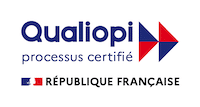Everything you need to know about B2B lead generation
More and more companies are aware that generating leads has become the main objective of any business. Yet the concept remains opaque to many, as do the techniques required to achieve it.
What is lead generation?
You hear a lot about lead generation. Like many companies, you'd like to master these techniques, the ones that will enable you to increase your sales.
But what exactly is a lead?
A lead is a person who has expressed an interest in the product or service you offer.
This person becomes a lead when they voluntarily provide you with their personal information:
- First and last name
- His e-mail address
- Phone number
- The name of his company...
Lead generation is a multi-stage process:
- The visitor establishes a point of contact, by visiting your website, your social networks...
- They receive a Call To Action proposing an offer: download an ebook, try a free software, receive a newsletter...
- By clicking on the CTA, he's redirected to a contact form to fill in. In exchange, they receive the offer.
Once the form has been filled in and validated, the visitor becomes a lead.

The lead at the heart of inbound marketing
Les techniques de génération de leads sont majoritairement mises en place par l’équipe marketing d’une entreprise, ou par des professionnels du marketing indépendants. Certains outils, comme LaGrowthMachine, se sont spécialisés dans les techniques de lead generation.
Aware of the weariness caused by outbound marketing (considered too intrusive by consumers), they are increasingly turning to inbound marketing, considered far more effective than outbound.
In fact, inbound marketing is based on two fundamental principles:
- The process is initiated by the potential customer (not the other way around)
- The problem faced by this potential customer is at the heart of the company's discourse (and not the product).
For the process to work, you need to attract visitors and make them want to provide their contact details.
Please note that a lead is not a prospect. At the lead stage, the person is in the discovery phase of the purchasing process. To become a prospect, they need to demonstrate an intention to buy.
Why is lead generation important in B2B?
A visitor who becomes a lead is a person who shows an initial interest in the company. They have a need and are looking to meet it.
Once captured, she'll be more inclined to complete the sales process, since she initiated it herself.
To achieve this, the company must :
- Be perceived as an expert by this lead
- Demonstrate added value vis-à-vis competitors
A lead is more likely to buy the product or service
67% of B2B customers make their purchase by consulting the Internet
This figure in itself is reason enough to start generating B2B leads.
The B2B customer will have consumed a great deal of information on the web, before embarking on a purchasing process.
To capture their attention, you need to offer them the right educational content at the right time.
An entrepreneur, whatever the size of his business, has no time to waste. When he does research, he does it with the aim of finding a solution.
Whoever captures their attention will have less difficulty bringing the sales process to a successful conclusion, because B2B leads are more qualified than B2C leads. They correspond to the company's target audience. They're your ideal customer.
B2B leads are often qualified
How can I optimize my lead generation?
To generate qualified leads, it's important to adopt an effective strategy, optimizing lead generation.
There are a few rules to follow.
Defining your persona
We can't stress this enough: the first thing to do is to define your persona perfectly.
In B2B, this is the company to which you offer your product.
To help you, you can answer a few questions such as :
- How big is the company?
- What is its business sector?
- What's the problem?
If you know your target audience inside out, you'll be able to offer them content tailored to their specific needs.

Careful content
In B2B, high value-added content is the key to lead generation. You need to demonstrate your expertise through the content you put online.
This content is designed to educate your target, especially if it's a lead nurturer who needs to be brought closer to a buying decision.
Your task is to attract visitors, arouse their interest and then convert them into leads.
Choosing the right publishing channels
There are a multitude of channels for generating leads. The first that springs to mind is the website. Through a blog section, many companies share high-value-added content.
But it's also possible to use social networks.
Create low-friction forms
Some visitors tend to give up when faced with a form that's too long or too intrusive.
Paying particular attention to the creation of the contact form is a key step in lead generation.
To do this, you can use different types of forms:
- Progressive forms, in 2 or 3 steps. E-mail address and telephone number are requested at the end.
- Autofill forms: with just an e-mail address, all other information is automatically retrieved. This saves time for the visitor.

What are the benefits of automation?
Why not automate lead generation?
Thanks to powerful tools, it's now possible to collect a vast amount of information, while assigning a quality score to each lead.
They have the advantage of reducing the workload of marketing teams and improving the quality of leads.
They also reduce the sales cycle and human error.
These software programs, which are highly prized by companies, can also be used to program formidable marketing campaigns, for example, relaunching a prospect who has not validated his shopping cart.
There are many tools available to automate lead generation. These include :
- LaGrowthMachine
- Phantombuster
- ProspectIn
- Expandi
- Apify...
It's worth noting that most of them generate leads from LinkedIn, the preferred network for B2B prospecting.
As you can see, generating qualified leads is the key to increasing sales. However, the process can sometimes be long and difficult. If this is the case, you can call on the services of marketing professionals who can put the right techniques in place.


